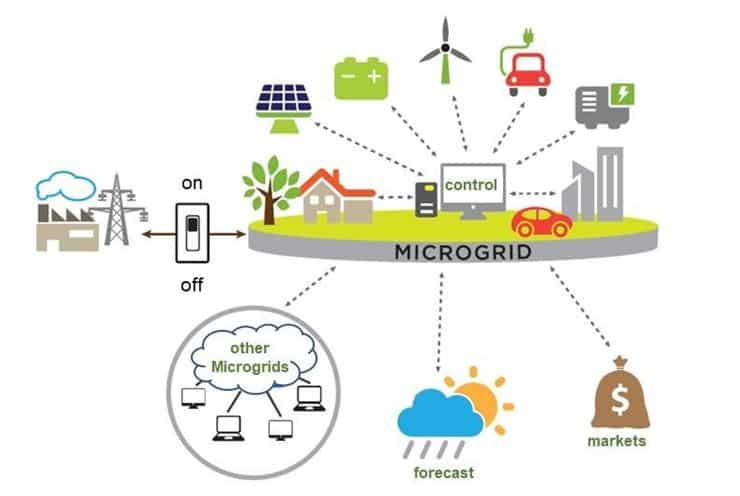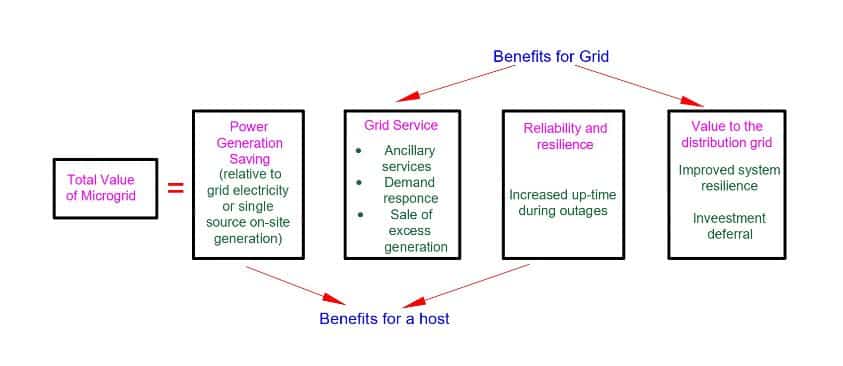A Microgrid can be defined as a local, confined, and self-sufficient energy system that has its own power generation sources capable to produce, store and supply energy to a localized area. In this article, we will discuss what is microgrids & their benefits.
Now, these localized areas can be any kind of geological areas such as a college campus, hospital complex or company building, or even a small neighborhood. Basically, Microgrids are comprised of distributed energy resources such as solar panels, wind turbines, battery energy storage systems which may or may not be interconnected together to form a complete unit. Based upon the connection with the main grid, a Microgrid can be differentiated as Grid-connected or island mode of Microgrid.
Types of Microgrids
1.) Grid Connected Mode: When a Microgrid is directly connected to the Main Grid it is known as Grid Connected Mode of connection.
2.) Islanded Mode: When a Microgrid can be connected to the utility grid as well as it can be isolated, it is known as Islanded Mode of connection of Microgrid.
3.) Stand-Alone(Isolated) Mode: When a Microgrid is completely isolated or the physical connection is absent between Microgrid and utility grid, it is known as a Stand-alone mode of operation.
A normal Microgrid should ensure the following aspects:
- It incorporates cost-competitive and efficient sources of clean energy such as solar, wind, CHP, mini-hydro, and thermal and electric storage.
- Maintaining terminal voltage regulation
- Proper current sharing among the distributed energy resources.
- Proper power flow to and from the utility/microgrid.
- Easy plug and play operation of DERs or addition or removal of energy storage.
- Integrates variable and intermittent renewable generation sources such as solar PV to leverage thermal, kinetic, and battery storage devices.
- They act as emergency shelters during extreme weather, earthquakes or fire conditions.
Microgrids can also be classified based on their type of power supply such as AC or DC Microgrids. DC Microgrids deal with loads that completely run on a DC power supply. Whereas, AC Microgrids deal with loads that can run on both DC and AC power supplies.
Microgrids Architecture

Microgrids have become a growing segment in the recent years of the energy industry which represents the transition from centralized station power plants to more localized, distributed generation. Microgrids can be made more resilient by islanded mode of connection whereby the ability to conduct flexible and parallel operations becomes more prominent.
Benefits of Microgrids
- It provides highly efficient, low cost and clean energy.
- Provides critical infrastructure that increases resilience and reliability
- It improves the stable operation of the regional electric grid
- Reduces the grid “congestion” and peak loads
- Offers grid services such as energy and ancillary services.

Barriers or Challenges faced by Microgrid
- Many a times we customize and incrementally install Microgrid deployments with organic increase in need. Due to which there is a limited number of scalable prototype installations and all-in-one deployments.
- Technical and operational challenges which include power quality (e.g., harmonics management, voltage and/or frequency control); grid synchronization; control strategies; control architecture; energy management; energy optimization; stability; protection protocols (e.g., during grid synchronization, transitions from islanded to grid-connected operating modes); initial design process of the microgrid; and the additional skill sets required of the operators.
- There are a very limited standards and interconnection protocols in a Microgrid.
- The disturbances due to power quality present in AC microgrids hugely affect the voltage and system frequency via voltage fluctuations, voltage notching, transients, harmonic distortion and outages. The poor power quality affects the consumers such as hospitals, data centers, high-tech manufacturers, financial traders, research labs and communications networks.
- We need control strategies to attain required microgrid parameters such as a high PQ, clean and cost-effective energy dispatch, demand-side management, combined heat and power management, supply/demand time of use strategies and compliance with main/utility grid interconnection agreements.
What is not a Microgrid?
A very common misconception among people is that they use the term ‘Microgrid‘ to describe a simple distributed energy system, such as rooftop solar panels. A key difference is that a Microgrid will keep the power flowing when the central grid fails whereas a solar panel alone will not. Many homeowners with solar panels are unaware of the fact and are surprised that they lose power during a grid outage.
Simple backup generators also cannot be considered Microgrids. Such systems are often employed only during emergencies. Whereas Microgrids can operate the whole year 24/7 managing and supplying energy to their customers.
RECENT DEVELOPMENTS IN MICROGRIDS IN INDIA
According to reports, the Indian government has issued a national policy on renewable energy-based Microgrids which proposes to set up at least 8000 renewable energy Microgrids across the country by 2023. The generation capacity is believed to be around 500 MW to cater to people and areas with energy shortages. So far 63 villages in India have been equipped with solar microgrids comprising around a capacity of 1800 kWh.
Read Next: